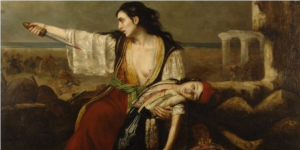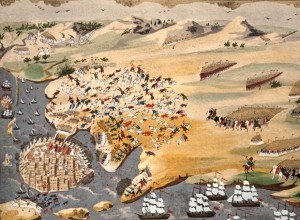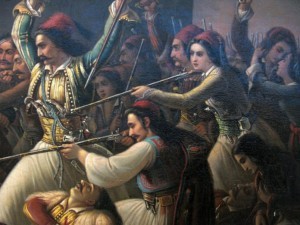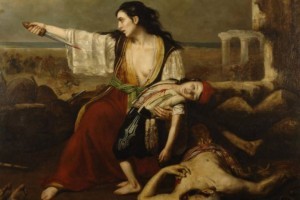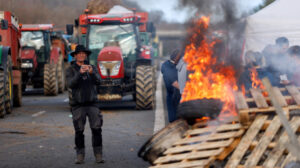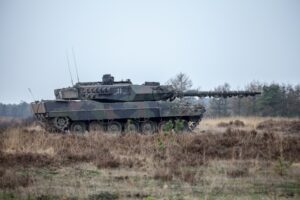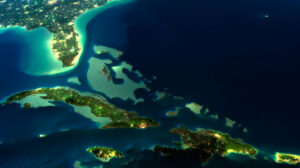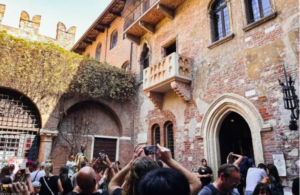Three years after the failed attempt to occupy Missolonghi, the Ottoman armies returned to besiege the city that had become the seat of the Senate of Western Continental Greece.
The siege lasted one year and the 10,500 city inhabitants eventually made the heroic “Exodus of Missolonghi” on 10 April 1826, adding another brilliant page in the Greek War of Independence Greece’s history.
The army of Resid Mehmed Pasha, or Kioutachis as Greeks called him, numbering 20,000 men. started the second siege of the city, later to be joined by another 10,000 men of Ibrahim Pasha who arrived from the Peloponnese campaign. It was April 15, 1825.
The siege of the city can be divided into two periods: a) April 15 to Dec. 12, 1825; and b) Dec. 25, 1825 to April 10, 1826. Without significant help from the rest of the Greeks due to the civil war, having to cope with superior enemy forces, the Missolonghi residents resisted bravely for one year.
A three-man committee organized the city’s defense: Ioannis Papadiamantopoulos; Dimitrios Themelis; and Georgios Kanavos.
The fortress of the city after the first siege had been restored and fortified, following the efforts of Alexandros Mavrokordatos, philhellene Lord Byron and engineer Michail Kokkinis.
Its trench was deeper and the courtyard was reinforced with towers, on which several cannons had been placed. The islet of Vassiladi, between the lagoon and the sea, became a kind of advanced fortress. There were six guns and 2,000 women and children were gathered so as not to burden the city guard.
Within Messolonghi there were 10,000 people, including 4,000 men, excellent warriors from Epirus and Aitoloakarnania and another 1,000 men capable of using weapons.
During the first phase of the siege (April 15 – Dec. 12, 1825) Missolonghi was besieged only by the forces of Kioutachis and their attacks were easily repelled. The siege from the sea was not strong enough and was repeatedly disrupted by Andreas Miaoulis’ fleet, which supplied the besieged citizens with munitions and food.
On July 24, 1,000 Russian soldiers under Georgios Karaiskakis forced the Ottomans to withdraw their forces to the foot of Mount Zygos, relaxing the siege of Missolonghi. The Turkish fleet, being harassed by the Greek, was forced to seek shelter in English-ruled Kefalonia.
On August 5, Kitsos Tzavellas, head of a group of fighters from Souli, entered the city, raising the morale of the besieged. But at the beginning of November, a fleet of Ottomans and Egyptians brought 8,000 Egyptian soldiers to the siege and a month later the army of Ibrahim Pasha came to the region. At the time, Ibrahim’s army numbered 25,000 troops comprised of Ottomans, Egyptians and Albanians commanded by French officers and with modern artillery at their disposal.
Greece Shows How to Handle the Crisis: Bloomberg
It was Dec. 25, 1825 when the second phase of the siege began. The two generals of the Ottoman forces where in disagreement and Ibrahim attacked the city first. On Jan. 16, 1826, Ibrahim admitted his failure to conquer the city and was forced to co-operate with Kioutachis.
The two armies had stunned the besieged Greeks with ruthless bombardment. They managed to take over the strategically important islets of Vassiladi (Feb. 25) and Kleisovas (March 25). After the fall of the two islets, the situation for the besieged became desperate, as Miaoulis and his ships could no longer bring supplies to the city.
Missolonghi was now without food. Soon they were forced to eat seaweed, mice and cats. Under the circumstances, it was impossible for the city to defend itself. On the April 6 the board of chieftains decided to make the exodus at midnight on the Saturday of Lazarus through the dawn of Palm Sunday (April 9 – 10).
At midnight, according to the plan, they were divided into three groups, under Dimitrios Makris, Notis Botsaris and Kitsos Tzavelas, in the hope of breaking enemy lines, taking the enemy by surprise. Earlier they had killed all Ottoman prisoners while only the wounded and the very old would remain in the city.
However, the plan was not carried out properly or there was a traitor who betrayed the scheme to the Ottomans. Ibrahim’s forces slaughtered the Greek freedom fighters who fought against all odds. Meanwhile, the enemy forces had invaded the city and killed everyone who was left behind.
It is estimated that 3,000 Greek men were killed during the Exodus of Missolonghi. The 6,000 women and children of the city were taken as slaves, sold to the slave markets of Constantinople and Alexandria. The Ottoman-Egyptian casualties amounted to 5,000 men.
The Ottoman victory proved to be Pyrrhic as the barbarity of Ibrahim’s troops and the heroism of the Greeks generated a new wave of philhellenism throughout Europe.
Missolonghi was liberated on May 11, 1829. In 1937 it was recognized as “Holy City” due to the mass slaughter of its citizens and Palm Sunday was designated as the anniversary of the Exodus.
Source: Philip Chrysopoulos/greekreporter
Ask me anything
Explore related questions
